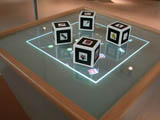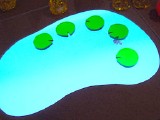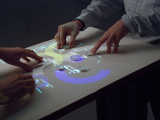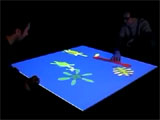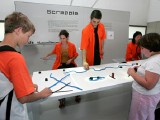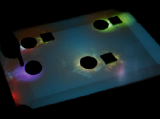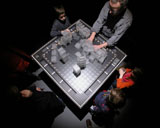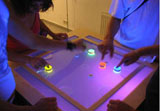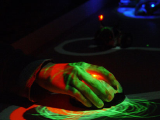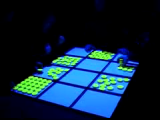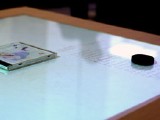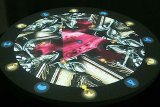Tangible Music Tables
-
audiopad
year: 2002
author(s): James Patten,
Ben Recht,
Hiroshi Ishii
affiliation: MIT Medialab,
Tangible Media Group
publication: Audiopad: A tagged based Interface for Musical Performance [PDF]
website: http://www.jamespatten.com/audiopad
Audiopad is a composition and performance instrument for electronic music which tracks the positions of objects on a tabletop surface and converts their motion into music. One can pull sounds from a giant set of samples, juxtapose archived recordings against warm synthetic melodies, cut between drum loops to create new beats, and apply digital processing all at the same time on the same table. Audiopad not only allows for spontaneous reinterpretation of musical compositions, but also creates a visual and tactile dialog between itself, the performer, and the audience.
-
reactable
year: 2004
author(s): Sergi Jordà,
Martin Kaltenbrunner,
Günter Geiger,
Marcos Alonso
affiliation: Music Technology Group,
Universitat Pompeu Fabra
publication: The reacTable: A collaborative Musical Instrument [PDF]
website: http://www.reactable.com/
The reactable is a tangible electronic musical instrument that allows expressive collaborative live performances for professional musicians without the limits of many screen-based interfaces for electronic
music. As its name suggests the reactable is a table-based instrument, it can be played by manipulating a set of objects that are distributed on top of an interactive table surface. Each of these objects has its dedicated function for the generation, modification or control of sound. Bringing these objects into proximity with each other constructs and plays the instrument at the same time. In addition to the sound which is obviously produced while playing, the reactable also provides additional visual feedback by projecting a visualization of the sound-flow onto the table surface.
-
smallfish
year: 2000
author(s): Masaki Fujihata,
Kiyoshi Furukawa,
Wolfgang Münch
affiliation: ZKM, Zentrum für Kunst und Medientechnologie
publication: Notes on Smallfish [PDF]
website: http://hosting.zkm.de/wmuench/small_fish
A musical installation with a tangible user interface, which is based on the original Smallfish CD-ROM. Smallfish is a visual score environment, where music is generated from impact events of moving and static objects. The smallfish table and the floor installation version use large plastic objects as barriers for the sound fish population.
-
scrapple
year: 2005
author(s): Golan Levin
affiliation: Carnegie Mellon University,
School of Art
publication: The Table is The Score: An Augmented-Reality Interface for Real-Time, Tangible, Spectrographic Performance [PDF]
website: http://www.flong.com/projects/scrapple/
Installation visitors can arrange the objects set up on a three-meter-long table any way they like, take some away, or let the wind-up toys find their own resting place. The changes in the alignment are interpreted by the installation as the notes of a musical score, whereby the positions of the individual elements on the horizontal and vertical lines determine the rhythms and pitches. The musical score is scanned at regular intervals and the notation created by the user is played back. A hybrid synthesizer (combining a granular and an additive sound synthesizer) produces four-second-long audio loops. Video projections refine the objects arrayed upon the Scrapple table.
-
Zen Waves
year: 2008
author(s): Eitan Glinert, Nozomi Kakikuchi, Jason Furtado, Tiffany Wang, Ben Howel
affiliation: Tangible Media Group, MIT Media Lab, Boston
website: http://www.eitanglinert.com/projects
Zen Waves is a digital take on the Zen garden that explores the use of tangible user interfaces in electronic art. The project is especially interesting because of the radically different input and output devices (there is no screen, mouse, or keyboard, just rocks and a table), and the fact that no instructions are required to use the device, users learn how to use Zen Waves by playing around with it.
-
Xenakis
year: 2007
author(s): Philipp Pötzl, Kai Linde, Max Meier, Bettina Conradi, Peter Lachenmaier, Markus Bischof
affiliation: Software Engineering, University of Augsburg
publication: Combining tangible interaction with probability-based musical composition [PDF]
website: http://xenakis.3-n.de/
Xenakis is a multi-user instrument to stochastically create music with a tangible interface. You can control the played instruments, their rhythmic and notes by moving physical objects on a luminous table surface. The Application is designed to provide a simple and easily accessible interface to a complex automatic composition technique. It has only three different types of controls for rhythmic elements, tone pitches and instruments.
-
music table
year: 2003
author(s): Rodney Berry,
Masami Suzuki,
Naoto Hikawa,
Mao Makino
affiliation: Advanced Telecommunication Research Institute, Media Information Science
publication: The Augmented Composer Project: The Music Table [PDF]
website: https://rodberry.net/research/interfaces-for-music-creation/
The Music Table is an experimental composing system that provides a tactile and visual representation of music that can be easily manipulated to make new musical patterns. It lets people experience their own music as patterns in musical space. Patterns of cards are arranged on a tabletop to become musical phrases. Completed phrases are stored on other cards and combined as multi-layered patterns. Animated characters provide fun visual feedback as you edit and arrange phrases, making abstract musical structures visible and tangible.
-
instant city
year: 2004
author(s): Sibylle Hauert, Daniel Reichmuth
affiliation: Rosen & Spademan Enterprise
publication: Ein elektronischer musik bau spiel automat [PDF]
website: http://www.instantcity.ch
Instant city, ein elektronischer musik bau spiel automat, is a music building game table. One or more players at a table can create architecture using semi-transparent building blocks and in the process make different modular compositions audible. Every performance is unique because the sequence, timing and combination possibilities are completely in the hands of the players! For each game one composition is chosen.
-
interactive surround sound (ISS) cube
year: 2007
author(s): Markus Quarta,
Christian Benesch,
Herbert Müller
affiliation: someth;ng
website: http://www.somethingonline.org/index.php?main=done&sub=iss_cube
The ISS cube is a surround sound mixer that tracks the position of several physical objects on a tabletop surface to provide the user with an intuitive way of creating a non-linear soundscape. Sounds of different categories can be added, combined and positioned in space by simply moving these objects. The sound space is provided by four surrounding speakers. Each object functions individually and simultaneously to modify the volume and position of different sound sources. With common audio mixing consoles and systems this would however not be possible as each sound source is usually mixed one after the other. The limitation is due to the nature of the input devices: joysticks on surround consoles and single mouse input on software systems.
-
audiocube
year: 2005
author(s): Daniel Dobler,
Philipp Stampfl
affiliation: Audite
website: http://www.im-services.at/index.php?id=31
AudioCube is an installation that allows a group of users to create their own three-dimensional soundscape. Four cubes are placed on a glass plate. Each side of the cubes refers to a different sound, each
cube refers to a category of sounds: drums, base, leads and strings. These cubes can then be turned to change the associated sound. The position of the cube on the glass plate refers to the position of the sound in the room. Due to this combination the users can create an individual soundscape within 3D-space. AudioCube was shown as a connection between the exhibitions musical instruments and medien.welten at the technical museum vienna.
-
ConDio
year: 2005
author(s): Talaganov Goce,
Cruz Mario Alberto,
Lorensen Christen Lau,
Thomsen Peter Pozza,
Fredslund Anders
affiliation: Allborg University Copenhagen
publication: ConDio, A Tangible Sound Experience [PDF]
website: http://media.aau.dk/~gtal05/condioProject.html
An Interactive Sound Effect Mixer that tracks Color & Movevent through Computer Vision and allows the Manipulation of various Audio Samples.
-
BlipTronic3000
year: 2005
author(s): Peter Benett,
Sean Toru,
Lisa Tutte-Scali
website: http://www.peteinfo.com/portfolio/bliptronic3000/
Bliptronic3000 is an inquiry into how the real and the virtual can be used together in a coherent artwork. A large majority of interactive digital artworks use a mouse and keyboard for input, and a computer screen (or maybe projection) for output. This may be fine for displaying the artwork on the Internet, however in a gallery situation there is the possibility of stronger interaction. It is this stronger interaction between the real and virtual that is the basis of our work. One of the ideas that we are trying to convey in the work is the difference between software and hardware. Namely how software is more flexible and numerous, and how hardware is generally slower and more prone to error.
-
Hap Hep Hip Hop
year: 2006
author(s): Guillermo Lorenzo
affiliation: Artist, Spain
website: http://guillermolorenzo.es/obra/hap-hep-hip-hop-ii
Interactive audio-visual installation. where the players can modify sound by placing pucks on virtual tracks on two tables. One of the tables is singing "hap hep hip hop" while the other serves as a mixing table. The visitors move the pucks on the table, which is divided into square regions. Each square senses the amount of light that is left through the objects, the more objects the more sound can be heard.
-
Beat Jigsaw
year: 2007
author(s): Gavin Morris
website: http://www.participationsystems.com/jigsaw.htm
The Beat Jigsaw is a jigsaw puzzle which the user can play with to create music and vj style graphics. The interface is a number of wooden blocks which can be slid around a table top. The arrangement of each piece in a certain position triggers a specific sound and corresponding video loop via a projector. By utilizing more and more pieces the user can build layers of samples and create his/her own music. The Beat Jigsaw is an Interactive Multimedia Installation which invites audience participation.
-
Tasting Music
year: 2002
author(s): Michihito Mizutani
affiliation: Media Lab Helsinki
website: http://www.michihito.com/11tastingmusic.html
This table recognizes which CD jacket is placed on it and shows the song list of the CD. The user can chose and play any song by moving the mouse device. This table is meant to be situated in a cafe or a music shop, where people can eat, drink and chat with friends. It is almost impossible to talk about a sound of a piece of music with your friends if you can not hear the sound of the music played.
-
froggies
year: 2004
author(s): Josh Nimoy
affiliation: New York University, Interactive Telecommunications Program
website: http://www.jtnimoy.net/itp/froggies/
Froggies is a play-testing prototype for a children's digital play environment. A table with a screen embedded into the surface acts as an arena for virtual life. Children react with the virtual life by placing various symbolic markers on the table and sliding them around. The result is a musical rhythm of animal noises.
-
orai/kalos
year: 2005
author(s): Paul Hertz
affiliation: Northwestern University, Center for Art and Technology
publication: Orai/Kalos: Installation Proposal [PDF]
website: http://paulhertz.net/orai/index.html
Orai/Kalos presents images and audio in an interactive computer-driven installation that continually varies its content and composition. Sound and image events are controlled by the same underlying parameters, and an interactive work, where each visitor generates new configurations. Visual and audio events consist of kaleidoscopic samples of natural and manmade patterns, plus underlying media-derived imagery.
